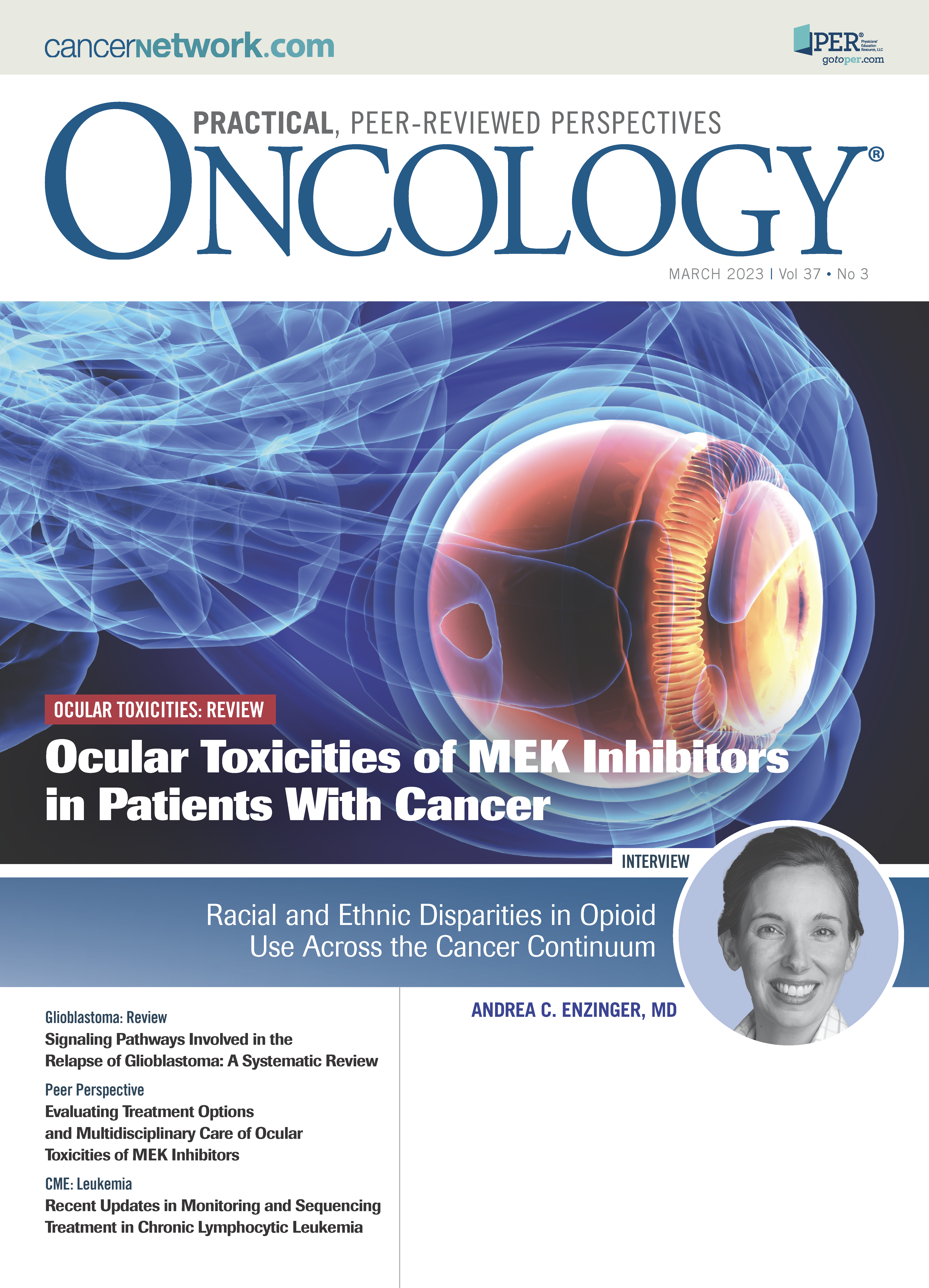Expert Reports on Racial Disparities in Opioid Access for End-of-Life Cancer
An expert from Dana-Farber Cancer Institute speaks not only to racial disparities in access to opioids for end-of-life cancer care but gender/racial discrepancies, as well.
A recent study, conducted between 2007 and 2019, aimed to determine the prevalence of racial and ethnic disparities in opioid access among Black, Hispanic, and White patients with cancer. The study found that there was a substantial gap in the ability to receive opioids, although socioeconomic factors did not play a role in this inequity.
Andrea C. Enzinger, MD, assistant professor of medicine at Harvard Medical School and a physician at Dana-Farber Cancer Institute

Some of the biggest disparities observed concerned the number of opioids received, disparities in long-acting opioids, and daily dose.
CancerNetwork® spoke with lead author, Andrea C. Enzinger, MD, an assistant professor of medicine at Harvard Medical School and a physician at Dana-Farber Cancer Institute, about a potential multipronged strategy that may work to mitigate these disparities including bias training for physicians and logistical support for patients.
Enzinger discussed the results from this trial, the barriers still to be overcome, and where the research may be headed.
CancerNetwork®: Can you discuss the racial and ethnic disparities in opioid access patients with cancer experienced at end of life?
Enzinger: We found striking and pervasive inequities in access to prescription opioids among older, Medicare-insured patients who are dying from cancer. We looked at more than 300,000 Black, White, and Hispanic patients with poor prognoses who died between 2007 and 2019.
If you looked at, for example, the proportion of patients who filled 1 or more opioid prescriptions in the last month of life, Black patients were about 4.3% less likely to fill any opioid prescription than White patients and Hispanic patients had a similar difference.
That may sound like a small number, but you have to keep in mind that by 2019, only a little more than 30% of patients filled a prescription for an opioid. If you’re looking at a 4.3% difference between Black and White patients with an overall cohort prevalence of about 30%, that’s a meaningful difference.
We saw larger differences in access to long-acting opioids, which are critical for palliating severe and persistent pain from advanced cancers. Black patients were about 3.2 percentage points less likely than White patients to fill a long-acting opioid in the last month of life. The differences are similar between Hispanic and White patients. To put that in context, by 2019, only about 9% of patients [dying of cancer] filled a long-acting opioid in the last month of life, so a difference of 3 or more percentage points is huge.
We also found that, when patients of color filled a prescription, the doses were lower. It’s useful to examine the difference in the average total dose filled by patients of color vs White patients. Just as an example, Black patients received or filled about 200 fewer mg of morphine equivalents in the last month of life than White patients, which amounts to around twenty-eight 5-mg oxycodone tablets. [That’s] about 1 less pill per day for the average Black patient compared with the average White patient. Again, we saw similar differences between Hispanic and White populations.
Which findings were most surprising?
Sadly, coming into this study, we did expect to see disparities in access because they’ve been shown across conditions and settings, including among pediatric populations and among patients with fractures [or] postoperative pain. What’s startling is that this is the population in whom you would hope to never see disparities—among people who are dying.
There are lots of downsides to prescription opioids, and one could argue that it’s a good thing that we’re not giving as many opioid pain medications in settings like [after] tooth extractions where we know they can lead to substance abuse and addiction. [However], these are dying patients, so it’s difficult to defend any disparity—especially [those of] the magnitude we observed.
Another surprising and disconcerting finding was that we saw huge variation if you drilled down beyond just race and ethnicity, and particularly if you look at the interaction between patients’ gender and race. Black men were dramatically more affected by disparities and opioid access vs any other group.
If you look, for example, at the difference between White men and Black men in access to prescription opioids, Black men were about 6 percentage points less likely to fill any opioid in the last month of life. They were more than 4% less likely to fill a long-acting opioid. If you look at the difference in total dose, they filled about 300 fewer mg of morphine equivalents than White men in the last month of life.
All the disparities were magnified substantially when examining Black men.
Are there any plans to continue this research?
Our team is planning several follow-up studies; there are some important unanswered questions. This is the largest study to date to examine the magnitude and scope of opioid access disparities in populations with cancer.
We’ve only just begun examining older populations with terminal cancer, and the degree of disparities seen with them is probably much larger if you examine younger populations or those with mixed insurance types. We’re interested in examining disparities in younger populations and those who may have Medicaid or commercial insurance.
We’re [also] interested in examining different phases of cancer care. For example, [we want to examine disparities] during definitive cancer treatment, or after surgery. It’s important to know where the disparities are the most extreme. The other thing our team is interested in looking at are the mechanisms: Why is this happening?
We tried to examine a few possible mechanisms by running models that adjusted for the characteristics of patients and the communities in which they lived. How deprived [are] the communities? We [were] wondering if this was all due to structural factors. Adjusting for that, for poverty, and whether patients lived in urban or rural communities made no difference in the magnitude of the disparities that we saw.
What strategies do you think could be implemented to help mitigate these disparities?
We’ll need to take a multipronged approach to tackle these disparities. We also need more information about what the key drivers are. There needs to be some element of bias training for providers.
We also need more logistical support around getting patients of color help in filling their prescriptions. [Patients] may face racial prejudices while trying to fill their prescriptions. They [also] may have difficulty getting to the pharmacy, or difficulty with co-pays.
[Further], we need institutional initiatives [toward] equity, and [the institutions need to] hold themselves accountable to those. I hope policymakers and insurers take a hard look at all the added regulations and burdens that they’ve placed on opioid prescription with the goal of reducing misuse and addiction. [Inadvertently], they may also be placing an undue burden on patients with cancer who need these medications, [especially] racial and ethnic minority patients.
Reference
Enzinger AC, Ghosh K, Keating NL, et al. Racial and ethnic disparities in opioid access and urine drug screening among older patients with poor-prognosis cancer near the end of life. J Clin Oncol. Published online January 10, 2023. doi:10.1200/JCO.22.01413

Oncologists Reflect on Pandemic's Lasting Impact on Cancer Care
Hear from leading cancer experts about the lasting impact the COVID-19 pandemic has left on clinical practice.